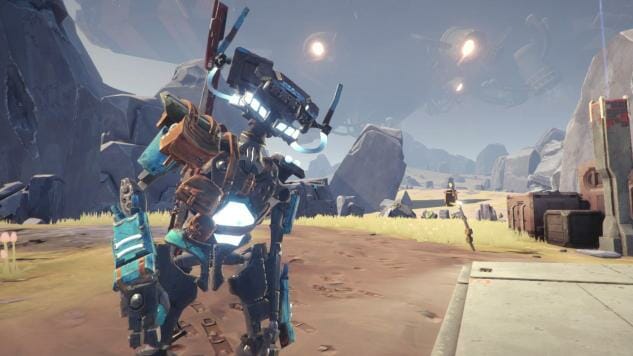
Aliens, high up in orbit, beam down controls into robot bodies. They’re searching for something, anything, some salvage or reality-warping objects that might change their whole way of building. The robotic forms weave in and out of the shapes of fallen gods, giant creatures whose forgotten builders left them strewn, in pieces, across an idyllic alien world. In The Signal From Tölva, you are those bodies. You’re each robot that explores this strange place. And for some reason, The Signal From Tölva didn’t make many end-of-year lists in 2017.
The mechanics are simple: You explore this strange world, hunting salvage and parts of story, and on the way you fight robots. The battles are quick and furious. The AI works realistically, with many laser and bullet battles starting at what feels like a couple hundred meters. Part of the trick is surviving and closing the distance, and the rock formations, crashed spaceships, and giant hollow robotic bodies that pepper the landscape are the perfect cover for helping achieve this. Tölva embraces the same pressures that PlayerUnknown’s Battlegrounds does by giving you broad, clear sightlines and asking you to figure out what to do about the large gap of space between you and your enemies.
And, often, you die. The lasers glitter as the light cuts down your robot body. Your brain flutters up into space, and they you’re right back down in the action again. You’re not a unique or individual robot. You’re a controller. Your lives are nearly infinite. In this way, The Signal From Tölva has the feeling of a roguelike. Is there a station you want to take over to uncover new portions of the map? You can brute force your way through it with your plenitude of bodies. Curious about what’s at the far edge of a canyon? Do it without fear, because nothing can be lost here.
This gameplay system of infinite bodies liberates the designers from having to worry about characterization of the protagonist. You’re simply a part of a bigger order of social organization and capitalist accumulation. You can flit from life to life without worry. There’s no Wolfenstein II monologues or Call of Duty narrative threads to follow. You’re simply on a mission to make sense of this space that you are wandering through. You’re also killing a lot of robots. A narrative emerges out of unlockable story chunks, sure, but no one is monologuing to you. You can simply live your life as an orbital robot possession creature making your way through artfully created spaces.
The level design in Tölva feels like it is still recovering from the splash zone of Half-Life 2, and that means that there are lots of corridors with clear objects in the distance. You want to get to that next little outcropping, and you need to hit that next checkpoint so you can climb up in a massive, smashed starship. These things are dangled in front of you, cleverly, so that you can’t help but want to approach them. This isn’t unique design; Half-Life 2, of course, dipped into it, and the Bioshock franchise and its many imitators have all worked to grab onto these design ideas.
The difference between those games and The Signal From Tölva is that Tölva isn’t interested in blowing your mind with powerful cinematic moments of bombastic narrative. There is a grounded realism to this universe, and even when it gets a little bit “weird sci-fi,” it doesn’t ever feel like that’s coming out of nowhere. That’s just the way this world is. It’s quotidian, but it’s warped in the same way our normal world is. After all, there are all kinds of people walking around our real world who claim to have seen ghosts. Ghosts and general weirdness aren’t that out there.
The Signal From Tölva was overlooked in 2017 by basically everyone, and to some degree I understand. It’s a thin game. There’s no massive web of NPCs, very few emergent systems, and Link isn’t even in it. I mean, gosh, if it were the thirteenth purchasable version of Skyrim, maybe that would have gotten people excited. But being a slight game serves The Signal From Tölva well. It can be picked up and put down with ease. There’s no massive sunk cost of time and effort. You grab it, you shoot robots, and you explore small pieces of a fantastic planet. And there’s something wonderful about that in our age of sprawling, immersive experiences.
Cameron Kunzelman tweets at @ckunzelman and writes about games at thiscageisworms.com. His latest game, Epanalepsis, was released last year. It’s available on Steam.